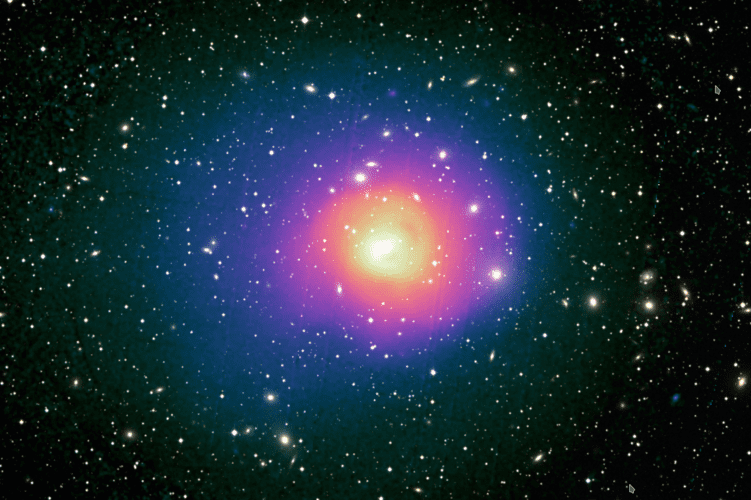ESA’s XMM-Newton X-ray observatory has spied hot gas sloshing around within a galaxy cluster – a never-before-seen behaviour that may be driven by turbulent merger events. To source


ESA’s XMM-Newton X-ray observatory has spied hot gas sloshing around within a galaxy cluster – a never-before-seen behaviour that may be driven by turbulent merger events. To source

Image: This image shows the bright, nearby, and massive Coma galaxy cluster in X-ray and optical light, as seen by XMM-Newton ’s European Photon Imaging Camera (EPIC) and the Sloan Digital Sky Survey (SDSS) . Using XMM-Newton to study Coma and another notably massive cluster, Perseus, astronomers spotted the first signs of gas sloshing around in […]

Image: This image shows the Perseus galaxy cluster – one of the most massive known objects in the Universe – in X-ray and optical light, as seen by XMM-Newton ’s European Photon Imaging Camera (EPIC) and the Digitzed Sky Survey II, respectively. Using XMM-Newton to study Perseus, astronomers spotted the first signs of this hot […]

Arianespace and ESA today announced the signature of a launch services contract for the Euclid satellite – with the mission’s timeframe for liftoff starting in mid-2022 from the Guiana Space Centre, Europe’s Spaceport in French Guiana. To source

Image: Many craters in the polar regions of Mars hold permanent ice deposits year-round. In this image, taken by the CaSSIS camera onboard ESA’s ExoMars Trace Gas Orbiter, the south-eastern wall of a 35 km-wide crater is seen. The image captures its permanent deposits of water ice, which survive the summer months due to the […]

Image: Ice capping the northern hemisphere terrain of Mars slowly recedes as summer progresses, revealing the underlying surface. This scene was captured by the CaSSIS camera onboard ESA’s ExoMars Trace Gas Orbiter as it flew over the ice-coated Korolev crater on 1 November 2019. Korolev crater is an 80 km-wide crater in the northern latitudes […]

Image: The rim of this ice-rich crater catches the early morning sunlight in the high northern latitudes of Mars, imaged by the CaSSIS camera onboard ESA’s ExoMars Trace Gas Orbiter on 26 October 2019. This image features a simple 7 km-wide bowl-shaped crater pictured in the early morning. The sunlight falling on the ice deposits […]

Image: This view may resemble a snowy scene observed from an airplane flying over Earth’s mountain ranges, but it is in fact a spectacular scene captured by the CaSSIS camera onboard ESA’s ExoMars Trace Gas Orbiter, or TGO, as it flew over the ice-coated Korolev crater on 21 August 2019. Korolev is an 80 km-wide […]

Image: The fairing of the Soyuz launcher that will lift ESA’s Cheops mission into space, along with the primary passenger, the Italian space agency’s Cosmo-SkyMed Second Generation satellite, and three CubeSats: ESA’s OPS-SAT and the French space agency’s CNES’s EYE-SAT and ANGELS satellites. Launch is scheduled for 17 December from Europe’s Spaceport in Kourou, French […]

Image: ESA’s Characterising Exoplanet Satellite, Cheops, encapsulated under the ASAP-S adapter of the Soyuz launcher, after having been moved to the platform of the transport module on 29 November. The two shells of the module were later closed and sealed before transport to the final integration building at Europe’s Spaceport in Kourou, French Guiana. Cheops is […]

Image: At Europe’s Spaceport in Kourou, French Guiana, ESA’s Characterising Exoplanet Satellite, Cheops, is being fitted into the flight adapter of the Soyuz-Fregat rocket that will lift it into space on 17 December. In this picture, taken on 29 November, the Souyuz Arianespace System for Auxiliary Payloads (ASAP-S) is progressively lowered, encapsulating Cheops. The ASAP-S […]

Image: At Europe’s Spaceport in Kourou, French Guiana, ESA’s Characterising Exoplanet Satellite, Cheops, is being fitted into the flight adapter of the Soyuz-Fregat rocket that will lift it into space on 17 December. In this picture, taken on 28 November, Cheops is hoisted above the conic flight adapter while the Airbus team is making sure […]

Image: The Cheops satellite being fuelled with hydrazine at Europe’s Spaceport in Kourou, French Guiana, on 23 November. A highly specialised team of fuellers is at work, protected by special suites. Fuelling is controlled via a dedicated set-up which allows to control accurately the quantity of propellant loaded in the satellite tank. Scheduled for launch on […]